Functionalization of Fluorine on the Surface of SnO2–Mg Nanocomposite as an Efficient Photocatalyst for Toxic Dye Degradation
Abstract
:1. Introduction
2. Experimental Procedure
2.1. Materials
2.2. Preparation of SnO2–Mg–F Nanocomposites
2.3. Sample Preparation for Decolorisation
2.4. Characterization Techniques
3. Results and Discussion
3.1. X-ray Diffraction Spectroscopy
3.2. Scanning Electron Microscope
3.3. Functional Group Analysis
3.4. Particle Size Analysis
3.5. UV-Visible Spectroscopy
3.6. Photoluminescence Spectroscopy
3.7. XPS Analysis
3.8. Photocatalytic Activity
4. Conclusions
Author Contributions
Funding
Data Availability Statement
Conflicts of Interest
References
- Awan, A.G. Relationship between environment and sustainable economic development: A theoretical approach to environmental problems. Int. J. Asian Soc. Sci. 2013, 3, 741–761. [Google Scholar]
- Kareem, M.; Bello, I.; Shittu, H.; Sivaprakash, P.; Adedokun, O.; Arumugam, S. Synthesis, characterization, and photocatalytic application of silver doped zinc oxide nanoparticles. Clean. Mater. 2022, 3, 100041. [Google Scholar] [CrossRef]
- Shittu, H.A.; Adedokun, O.; Kareem, M.A.; Sivaprakash, P.; Bello, I.T.; Arumugam, S. Effect of low-doping concentration on silver-doped SnO2 and its photocatalytic applications. Bio-Interface Res. Appl. Chem. 2023, 13, 165. [Google Scholar]
- Usman, M.; Ahmed, A.; Yu, B.; Peng, Q.; Shen, Y.; Cong, H. Photocatalytic potential of bio-engineered copper nanoparticles synthesized from Ficus carica extract for the degradation of toxic organic dye from waste water: Growth mechanism and study of parameter affecting the degradation performance. Mater. Res. Bull. 2019, 120, 110583. [Google Scholar] [CrossRef]
- Pang, Y.L.; Lim, S.; Ong, H.C.; Chong, W.T. Research progress on iron oxide-based magnetic materials: Synthesis techniques and photocatalytic applications. Ceram. Int. 2016, 42, 9–34. [Google Scholar] [CrossRef]
- Vattikuti, S.P.; Reddy, P.A.K.; Shim, J.; Byon, C. Visible-light-driven photocatalytic activity of SnO2–ZnO quantum dots anchored on g-C3N4 nanosheets for photocatalytic pollutant degradation and H2 production. ACS Omega 2018, 3, 7587–7602. [Google Scholar] [CrossRef]
- Li, S.; Luo, Y.; Lv, W.; Yu, W.; Wu, S.; Hou, P.; Yang, Q.; Meng, Q.; Liu, C.; Cheng, H.-M. Vertically aligned carbon nanotubes grown on graphene paper as electrodes in lithium-ion batteries and dye-sensitized solar cells. Adv. Energy Mater. 2011, 1, 486–490. [Google Scholar] [CrossRef]
- Aarthi, A.; Umadevi, M.; Parimaladevi, R.; Sathe, G.V.; Arumugam, S.; Sivaprakash, P. A Negatively Charged Hydrophobic Hemi-micelle of Fe3O4/Ag MNP Role towards SERS, Photocatalysis and Bactericidal. J. Inorg. Organomet. Polym. Mater. 2021, 31, 1469–1479. [Google Scholar] [CrossRef]
- Hu, X.; Li, G.; Yu, J.C. Design, fabrication, and modification of nanostructured semiconductor materials for environmental and energy applications. Langmuir 2010, 26, 3031–3039. [Google Scholar] [CrossRef]
- Shaheen, N.; Yousuf, M.A.; Shakir, I.; Zulfiqar, S.; Agboola, P.O.; Warsi, M.F. Wet chemical route synthesis of spinel oxide nano-catalysts for photocatalytic applications. Phys. B Condens. Matter 2020, 580, 411820. [Google Scholar] [CrossRef]
- Vadivel, S.; Rajarajan, G. Effect of Mg doping on structural, optical and photocatalytic activity of SnO2 nanostructure thin films. J. Mater. Sci. Mater. Electron. 2015, 26, 3155–3162. [Google Scholar] [CrossRef]
- Gupta, M.; Ling, S.N.M. Magnesium, Magnesium Alloys, and Magnesium Composites; John Wiley & Sons: Hoboken, NJ, USA, 2011. [Google Scholar]
- Julien, P.; Bergthorson, J.M. Enabling the metal fuel economy: Green recycling of metal fuels. Sustain. Energy Fuels 2017, 1, 615–625. [Google Scholar] [CrossRef]
- Kannan, K.; Radhika, D.; Sadasivuni, K.K.; Reddy, K.R.; Raghu, A.V. Nanostructured metal oxides and its hybrids for photocatalytic and biomedical applications. Adv. Colloid Interface Sci. 2020, 281, 102178. [Google Scholar] [CrossRef] [PubMed]
- Zhu, G.; Lin, T.; Lü, X.; Zhao, W.; Yang, C.; Wang, Z.; Wang, Z.; Yin, H.; Liu, Z.; Huang, F.; et al. Black brookite titania with high solar absorption and excellent photocatalytic performance. J. Mater. Chem. A 2013, 1, 9650–9653. [Google Scholar] [CrossRef]
- Zhang, H.; Chen, G.; Bahnemann, D.W. Photoelectrocatalytic materials for environmental applications. J. Mater. Chem. 2009, 19, 5089. [Google Scholar] [CrossRef]
- Ling, F.; Li, W.; Ye, L. The synergistic effect of non-metal doping or defect engineering and interface coupling on the photocatalytic property of g-C3N4: First-principle investigations. Appl. Surf. Sci. 2019, 473, 386–392. [Google Scholar] [CrossRef]
- Kumaran, N.N.; Muraleedharan, K. Photocatalytic activity of ZnO and Sr2+ doped ZnO nanoparticles. J. Water Process Eng. 2017, 17, 264–270. [Google Scholar] [CrossRef]
- Sasikala, R.; Shirole, A.; Sudarsan, V.; Kamble, V.; Sudakar, C.; Naik, R.; Rao, R.; Bharadwaj, S. Role of support on the photocatalytic activity of titanium oxide. Appl. Catal. A Gen. 2010, 390, 245–252. [Google Scholar] [CrossRef]
- Akbari, A.; Sabouri, Z.; Hosseini, H.A.; Hashemzadeh, A.; Khatami, M.; Darroudi, M. Effect of nickel oxide nanoparticles as a photocatalyst in dyes degradation and evaluation of effective parameters in their removal from aqueous environments. Inorg. Chem. Commun. 2020, 115, 107867. [Google Scholar] [CrossRef]
- Devi, L.G.; Shyamala, R. Photocatalytic activity of SnO2–α-Fe2O3 composite mixtures: Exploration of number of active sites, turnover number and turnover frequency. Mater. Chem. Front. 2018, 2, 796–806. [Google Scholar] [CrossRef]
- Mani, R.; Vivekanandan, K.; Vallalperuman, K. Synthesis of pure and cobalt (Co) doped SnO2 nanoparticles and its structural, optical and photocatalytic properties. J. Mater. Sci. Mater. Electron. 2017, 28, 4396–4402. [Google Scholar] [CrossRef]
- Ben Soltan, W.; Lassoued, M.S.; Ammar, S.; Toupance, T. Vanadium doped SnO2 nanoparticles for photocatalytic degradation of methylene blue. J. Mater. Sci. Mater. Electron. 2017, 28, 15826–15834. [Google Scholar] [CrossRef]
- Basavarajappa, P.S.; Patil, S.B.; Ganganagappa, N.; Reddy, K.R.; Raghu, A.V.; Reddy, C.V. Recent progress in metal-doped TiO2, non-metal doped/codoped TiO2 and TiO2 nanostructured hybrids for enhanced photocatalysis. Int. J. Hydrog. Energy 2020, 45, 7764–7778. [Google Scholar] [CrossRef]
- Chen, X.; Li, C.; Grätzel, M.; Kostecki, R.; Mao, S.S. Nanomaterials for renewable energy production and storage. Chem. Soc. Rev. 2012, 41, 7909–7937. [Google Scholar] [CrossRef] [PubMed]
- Sangari, M.; Umadevi, M.; Mayandi, J.; Pinheiro, J.P. Photocatalytic degradation and antimicrobial applications of F-doped MWCNTs/TiO2 composites. Spectrochim. Acta Part A Mol. Biomol. Spectrosc. 2015, 139, 290–295. [Google Scholar] [CrossRef]
- Fujihara, S. Sol-gel processing of fluoride and oxyfluoride materials. Handb. Sol-Gel Sci. Technol. 2018, 1, 219. [Google Scholar]
- Rajaitha, P.M.; Hajra, S.; Sahu, M.; Mistewicz, K.; Toroń, B.; Abolhassani, R.; Panda, S.; Mishra, Y.K.; Kim, H.J. Unraveling highly efficient nanomaterial photocatalyst for pollutant removal: A comprehensive review and future progress. Mater. Today Chem. 2022, 23, 100692. [Google Scholar] [CrossRef]
- Jyothi, N.S.; Ravichandran, K. Optimum pH for effective dye degradation: Mo, Mn, Co and Cu doped ZnO photocatalysts in thin film form. Ceram. Int. 2020, 46, 23289–23292. [Google Scholar] [CrossRef]
- Zhu, H.; Yang, D.; Yu, G.; Zhang, H.; Yao, K. A simple hydrothermal route for synthesizing SnO2 quantum dots. Nanotechnology 2006, 17, 2386–2389. [Google Scholar] [CrossRef]
- Cao, Y.; Jiao, Q.; Zhao, Y.; Dong, Y. Decorating Mg/Fe oxide nanotubes with nitrogen-doped carbon nanotubes. J. Alloys Compd. 2011, 509, 9372–9376. [Google Scholar] [CrossRef]
- Joshua, J.R.; Sharmila, V.; Viji, A.; Alam, M.W.; BaQais, A.; Shajahan, S.; Abu Haija, M.; Acevedo, R. Electrochemical Performance of Spongy Snowballs of O3-NaFeO2@SnO: Cathodes for Sodium Ion Batteries. Int. J. Energy Res. 2023, 2023, 6616567. [Google Scholar] [CrossRef]
- Tezel, F.M.; Kariper, A. Synthesis, surface tension, optical and dielectric properties of bismuth oxide thin film. Mater. Sci. 2017, 35, 87–93. [Google Scholar] [CrossRef]
- Kumari, R.; Kumar, A.; Mishra, N.K.; Sahu, S.K. Polymer-Induced Emission-Active Fluorine-Embedded Carbon Dots for the Preparation of Warm WLEDs with a High Color Rendering Index. Langmuir 2022, 38, 9389–9399. [Google Scholar] [CrossRef] [PubMed]
- Ramasamy, V.; Vijayalakshmi, G. Effect of Zn doping on structural, optical and thermal properties of CeO2 nanoparticles. Superlattices Microstruct. 2015, 85, 510–521. [Google Scholar] [CrossRef]
- Prziwara, P.; Breitung-Faes, S.; Kwade, A. Impact of grinding aids on dry grinding performance, bulk properties and surface energy. Adv. Powder Technol. 2018, 29, 416–425. [Google Scholar] [CrossRef]
- Mattsson, A.; Leideborg, M.; Larsson, K.; Westin, G.; Österlund, L. Adsorption and solar light decomposition of acetone on anatase TiO2 and niobium doped TiO2 thin films. J. Phys. Chem. B 2006, 110, 1210–1220. [Google Scholar] [CrossRef] [PubMed]
- Viji, A.; Vijayakumar, R.; Balachandran, V.; Vanasundari, K.; Janaki, M. Molecular docking and computational studies investigation on a bioactive anti-cancer drug: Thiazole derivatives. Indian J. Chem. Technol. IJCT 2022, 29, 616–634. [Google Scholar]
- Viji, A.; Revathi, B.; Balachandran, V.; Babiyana, S.; Narayana, B.; Salian, V.V. Analysis of spectroscopic, quantum chemical calculations, molecular docking, RDG, ELF, anticancer and antimicrobial activity studies on bioactive molecule 2-[3-(4-Chlorophenyl)-5-(4-(propane-2-yl) phenyl-4,5-dihydro-1H-pyrazol-1-yl]-4-(4-methoxyphenyl)-1,3-thiazol. Chem. Data Collect. 2020, 30, 100585. [Google Scholar] [CrossRef]
- Viji, A.; Balachandran, V.; Babiyana, S.; Narayana, B.; Saliyan, V.V. Molecular docking and quantum chemical calculations of 4-methoxy-{2-[3-(4-chlorophenyl)-5-(4-(propane-2-yl) PHENYL)-4, 5-dihydro-1h-pyrazol-1-yl]-1, 3-thiazol-4-yl} phenol. J. Mol. Struct. 2020, 1203, 127452. [Google Scholar] [CrossRef]
- Zviagina, B.B.; Drits, V.A.; Dorzhieva, O.V. Distinguishing Features and Identification Criteria for K-Dioctahedral 1M Micas (Illite-Aluminoceladonite and Illite-Glauconite-Celadonite Series) from Middle-Infrared Spectroscopy Data. Minerals 2020, 10, 153. [Google Scholar] [CrossRef]
- Hamzaoui, R.; Bouchenafa, O.; Ben Maaouia, O.; Guessasma, S. Introduction of milled kaolinite obtained by mechanosynthesis to cement mixture for the production of mortar: Study of mechanical performance of modified mortar. Powder Technol. 2019, 355, 340–348. [Google Scholar] [CrossRef]
- Ziemath, E.C.; Saggioro, B.Z.; Fossa, J.S. Physical properties of silicate glasses doped with SnO2. J. Non-Cryst. Solids 2005, 351, 3870–3878. [Google Scholar] [CrossRef]
- Wong, C.W.; Chan, Y.S.; Jeevanandam, J.; Pal, K.; Bechelany, M.; Abd Elkodous, M.; El-Sayyad, G.S. Response Surface Methodology Optimization of Mono-dispersed MgO Nanoparticles Fabricated by Ultrasonic-Assisted Sol–Gel Method for Outstanding Antimicrobial and Antibiofilm Activities. J. Clust. Sci. 2020, 31, 367–389. [Google Scholar] [CrossRef]
- Ahmad, I.; Ahmed, E.; Ahmad, M.; Akhtar, M.S.; Basharat, M.A.; Khan, W.Q.; Ghauri, M.I.; Ali, A.; Manzoor, M.F. The investigation of hydrogen evolution using Ca doped ZnO catalysts under visible light illumination. Mater. Sci. Semicond. Process. 2020, 105, 104748. [Google Scholar] [CrossRef]
- Ravichandran, K.; Dhanraj, C.; Ibrahim, M.M.; Kavitha, P. Enhancing the photocatalytic efficiency of ZnO thin films by the addition of Mo and rGO. Mater. Today Proc. 2022, 48, 234–244. [Google Scholar] [CrossRef]
- Balakrishnan, G.; Velavan, R.; Batoo, K.M.; Raslan, E.H. Microstructure, optical and photocatalytic properties of MgO nanoparticles. Results Phys. 2020, 16, 103013. [Google Scholar] [CrossRef]
- Kumar, K.A.; Subalakshmi, K.; Sekar, S.; Sivaprakash, P.; Kim, I.; Kumar, S.A.; Lee, S.; Arumugam, S. Hexagonal cage like structured reduced graphene Oxide-NiCo2S4 nanocomposite for high performance hydrogen evolution reaction. Int. J. Hydrog. Energy 2023. [Google Scholar] [CrossRef]
- Selvam, N.C.S.; Kumar, R.T.; Kennedy, L.J.; Vijaya, J.J. Comparative study of microwave and conventional methods for the preparation and optical properties of novel MgO-micro and nano-structures. J. Alloys Compd. 2011, 509, 9809–9815. [Google Scholar] [CrossRef]
- Mazánek, V.; Jankovský, O.; Luxa, J.; Sedmidubský, D.; Janoušek, Z.; Šembera, F.; Mikulics, M.; Sofer, Z. Tuning of fluorine content in graphene: Towards large-scale production of stoichiometric fluorographene. Nanoscale 2015, 7, 13646–13655. [Google Scholar] [CrossRef]
- Tuttle, J.; Albin, D.; Noufi, R. Thoughts on the microstructure of polycrystalline thin film CuInSe2 and its impact on material and device performance. Sol. Cells 1991, 30, 21–38. [Google Scholar] [CrossRef]
- Bayal, N.; Jeevanandam, P. Sol–gel synthesis of SnO2–MgO nanoparticles and their photocatalytic activity towards methylene blue degradation. Mater. Res. Bull. 2013, 48, 3790–3799. [Google Scholar] [CrossRef]
- Meng, D.; Liu, D.; Wang, G.; Shen, Y.; San, X.; Li, M.; Meng, F. Low-Temperature Formaldehyde Gas Sensors Based on NiO-SnO2 Heterojunction Microflowers Assembled by Thin Porous Nanosheets. Sens. Actuators B Chem. 2018, 273, 418–428. [Google Scholar] [CrossRef]
- He, J.; Jiao, W.; Zhang, L.; Feng, R. Preparation and Gas-Sensing Performance of SnO2/NiO Composite Oxide Synthesized by Microwave-Assisted Liquid Phase Deposition. Particuology 2018, 41, 118–125. [Google Scholar] [CrossRef]
- Bai, S.; Liu, J.; Guo, J.; Luo, R.; Li, D.; Song, Y.; Liu, C.C.; Chen, A. Facile Preparation of SnO2/NiO Composites and Enhancement of Sensing Performance to NO2. Sens. Actuators B Chem. 2017, 249, 22–29. [Google Scholar] [CrossRef]
- Zhu, J.; Zhu, Y.; Zhou, Y.; Wu, C.; Chen, Z.; Chen, G. Synergistic Promotion of Photocatalytic Degradation of Methyl Orange by Fluorine-and Silicon-Doped TiO2/AC Composite Material. Molecules 2023, 28, 5170. [Google Scholar] [CrossRef]
- Pandey, S.; Do, J.Y.; Kim, J.; Kang, M. Fast and highly efficient catalytic degradation of dyes using κ-carrageenan stabilized silver nanoparticles nanocatalyst. Carbohydr. Polym. 2020, 230, 115597. [Google Scholar] [CrossRef]
- Eskikaya, O.; Gun, M.; Bouchareb, R.; Bilici, Z.; Dizge, N.; Ramaraj, R.; Balakrishnan, D. Photocatalytic activity of calcined chicken eggshells for Safranin and Reactive Red 180 decolorization. Chemosphere 2022, 304, 135210. [Google Scholar] [CrossRef]
- Ravichandran, K.; Jyothi, N.S.; Rathi, R.; Dineshbabu, N.; Shalini, R.; Viji, A.; Neethidevan, K. Intermediate electron trap levels generation and enhanced carrier concentration in ZnO by strontium and molybdenum co-doping: An effective approach for dye degradation. J. Mater. Sci. Mater. Electron. 2023, 34, 5. [Google Scholar] [CrossRef]
- Gharagozlou, M.; Bayati, R. Photocatalytic activity and formation of oxygen vacancies in cation doped anatase TiO2 nanoparticles. Ceram. Int. 2014, 40, 10247–10253. [Google Scholar] [CrossRef]
- Bilal Tahir, M.; Nadeem Riaz, K.; Asiri, A.M. Boosting the performance of visible light-driven WO3/g-C3N4 anchored with BiVO4 nanoparticles for photocatalytic hydrogen evolution. Int. J. Energy Res. 2019, 43, 5747–5758. [Google Scholar] [CrossRef]
- Adedokun, O.; Sivaprakash, P.; Ajani, A.S.; Bello, I.T.; Arumugam, S. Structural, optical and magnetic studies of sol-gel synthesized Mg-doped pure anatase TiO2 nanoparticles for spintronic and optoelectronics applications. Phys. B Condens. Matter. 2023, 665, 415199. [Google Scholar] [CrossRef]
- Kosslick, H.; Tuan, V.A.; Bahnemann, D.W. In Situ Studies on photocatalytic materials, surface intermediates, and reaction mechanisms. In Heterogeneous Catalysts for Clean Technology; Wiley-VCH Verlag GmbH & Co. KGaA: Weinheim, Germany, 2013; pp. 65–102. [Google Scholar]
- Vlasov, M.I.; Tarasova, N.A.; Galisheva, A.O.; Animitsa, I.E.; Ananyev, M.V. Band gap engineering and transport properties of Ba2In2O5: Effect of fluorine doping and hydration. Phys. Chem. Chem. Phys. 2019, 21, 23459–23465. [Google Scholar] [CrossRef] [PubMed]
- Kumar, S.; Gawande, M.B.; Kopp, J.; Kment, S.; Varma, R.S.; Zbořil, R. P- and F-co-doped carbon nitride nanocatalysts for photocatalytic CO2 reduction and thermocatalytic furanics synthesis from sugars. ChemSusChem 2020, 13, 5231–5238. [Google Scholar] [CrossRef] [PubMed]
- Sivaprakash, P.; Ananth, A.N.; Nagarajan, V.; Parameshwari, R.; Arumugam, S.; Jose, S.P.; Muthu, S.E. Role of Sm3+ dopant in the formation of La(1−x)SmxCrO3 solid state nanoperovskites–correlation of its augmented physical properties. Mater. Chem. Phys. 2020, 248, 122922. [Google Scholar] [CrossRef]
- Velmurugan, G.; Ganapathi Raman, R.; Prakash, D.; Kim, I.; Sahadevan, J.; Sivaprakash, P. Influence of Ni and Sn Perovskite NiSn(OH)6 Nanoparticles on Energy Storage Applications. Nanomaterials 2023, 13, 1523. [Google Scholar] [CrossRef]
- Ramanathan, G.; Murali, K.R. Photocatalytic activity of SnO2 nanoparticles. J. Appl. Electrochem. 2022, 52, 849–859. [Google Scholar] [CrossRef]
- Suresh, K.C.; Surendhiran, S.; Kumar, P.M.; Kumar, E.R.; Khadar, Y.A.S.; Balamurugan, A. Green synthesis of SnO2 nanoparticles using Delonix elata leaf extract: Evaluation of its structural, optical, morphological and photocatalytic properties. SN Appl. Sci. 2020, 2, 1735. [Google Scholar] [CrossRef]
- Lamba, R.; Umar, A.; Mehta, S.K.; Kansal, S.K. ZnO doped SnO2 nanoparticles heterojunction photo-catalyst for environmental remediation. J. Alloys Compd. 2015, 653, 327–333. [Google Scholar] [CrossRef]
- Ahmed, A.; Naseem Siddique, M.; Alam, U.; Ali, T.; Tripathi, P. Improved Photocatalytic Activity of Sr Doped SnO2 Nano-particles: A Role of Oxygen Vacancy. Appl. Surf. Sci. 2019, 463, 976–985. [Google Scholar] [CrossRef]
- Padmaja, B.; Dhanapandian, S.; Ashokkumar, K. Hydrothermally Derived Mg Doped Tin Oxide Nanostructures for Photo-catalytic and Supercapacitor Applications. Mater. Sci. Eng. B 2023, 297, 116699. [Google Scholar] [CrossRef]
- Lázaro-Navas, S.; Prashar, S.; Fajardo, M.; Gómez-Ruiz, S. Visible light-driven photocatalytic degradation of the organic pollutant methylene blue with hybrid palladium–fluorine-doped titanium oxide nanoparticles. J. Nanopart. Res. 2015, 17, 94. [Google Scholar] [CrossRef]
- Huang, T.; Mao, S.; Yu, J.; Wen, Z.; Lu, G.; Chen, J. Effects of N and F doping on structure and photocatalytic properties of anatase TiO2 nanoparticles. RSC Adv. 2013, 3, 16657–16664. [Google Scholar] [CrossRef]
- Elango, G.; Roopan, S.M. Efficacy of SnO2 nanoparticles toward photocatalytic degradation of methylene blue dye. J. Photochem. Photobiol. B 2016, 155, 34–38. [Google Scholar] [CrossRef] [PubMed]
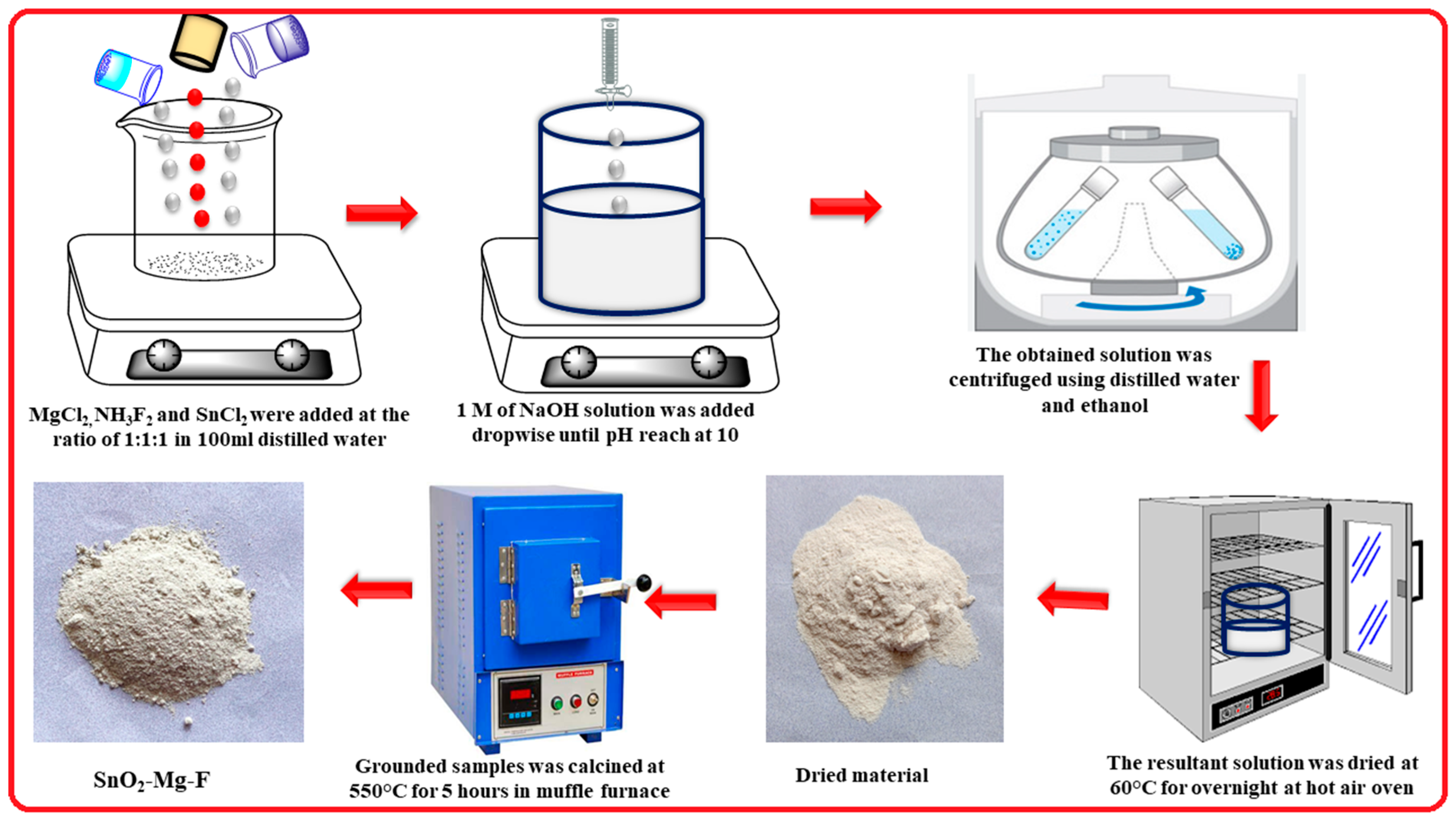

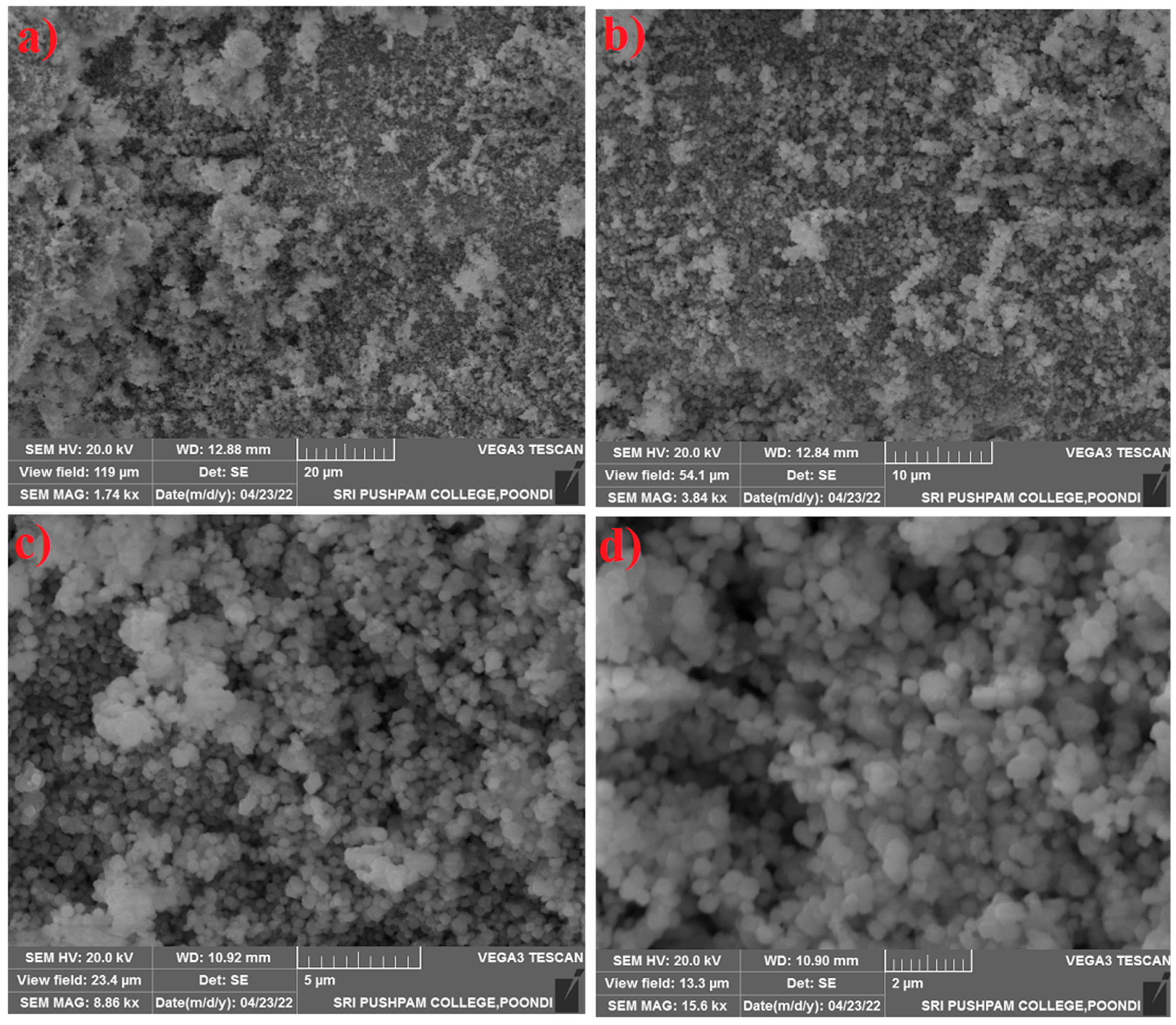
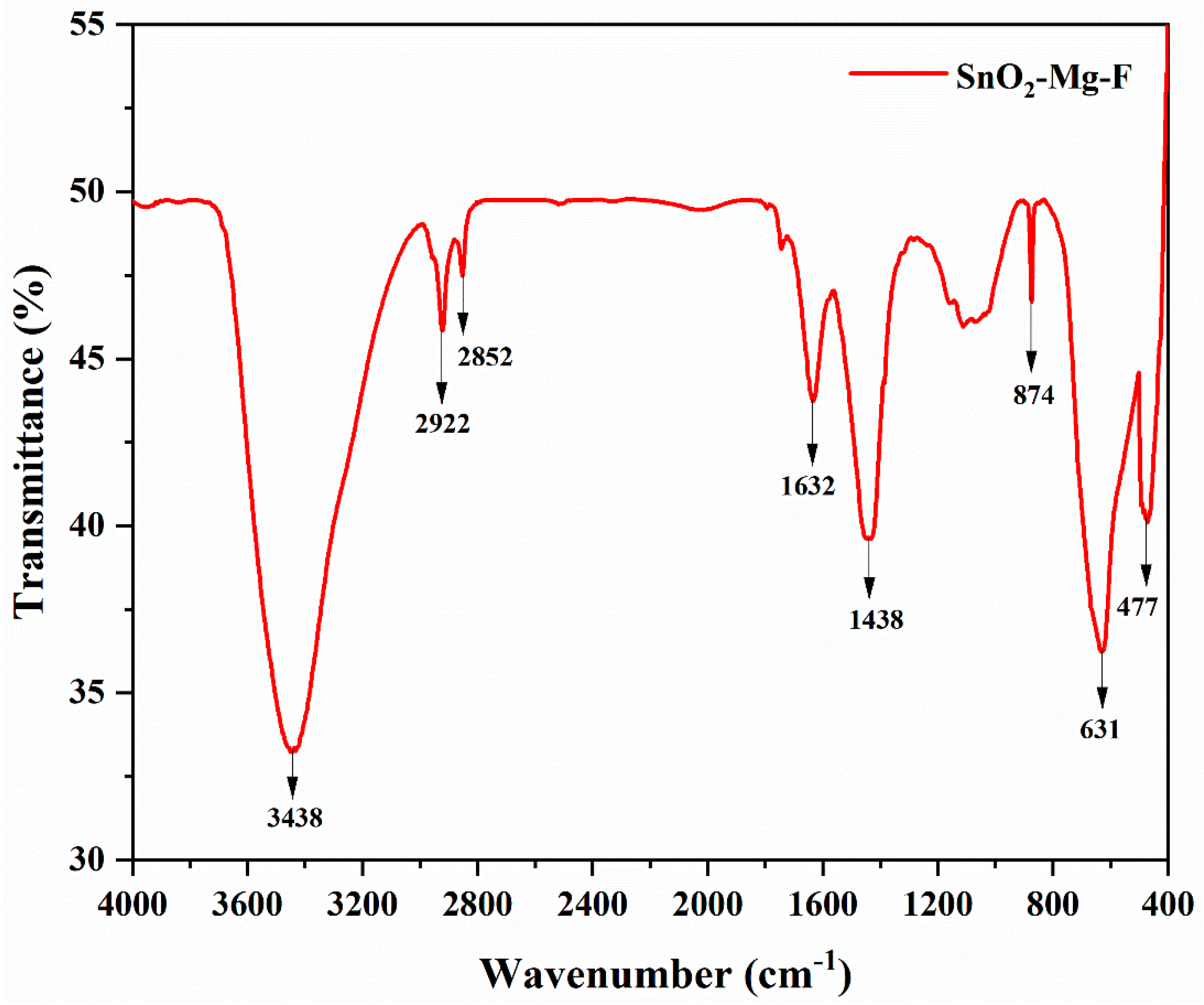

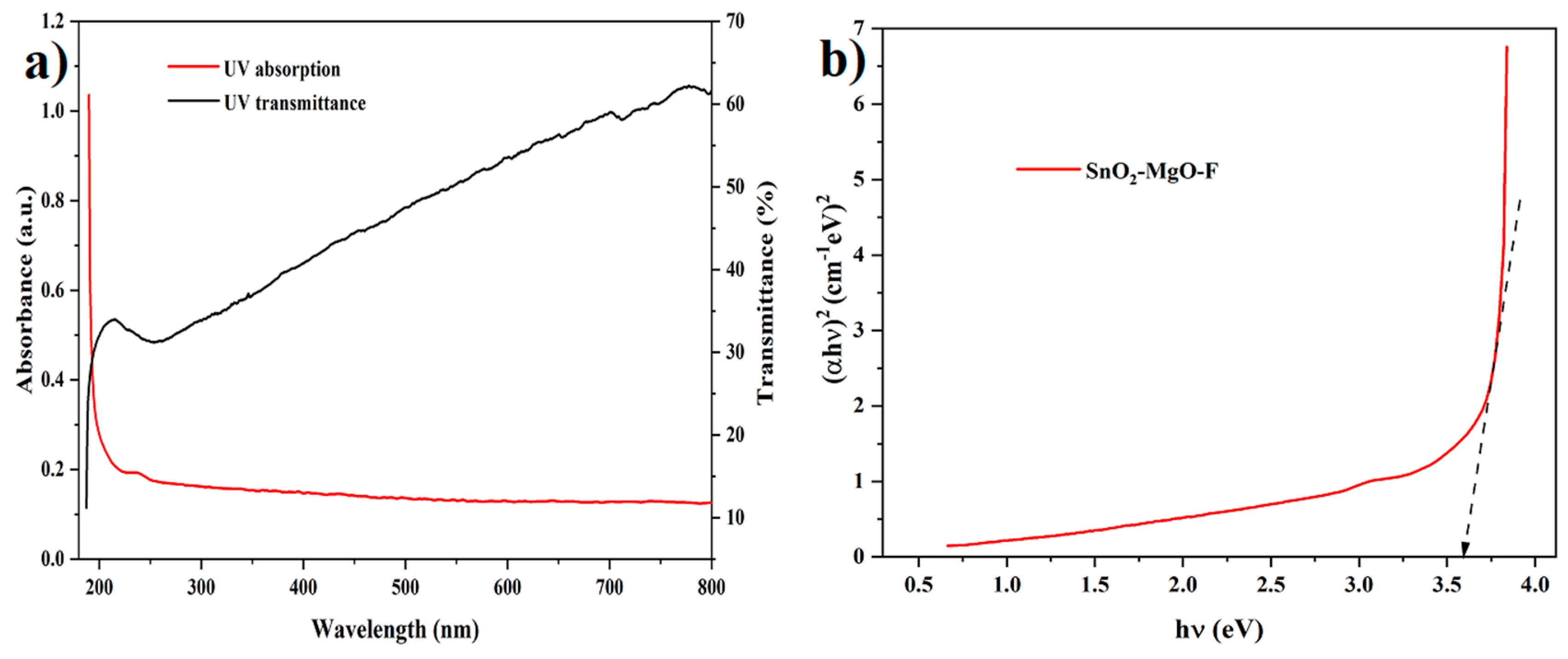
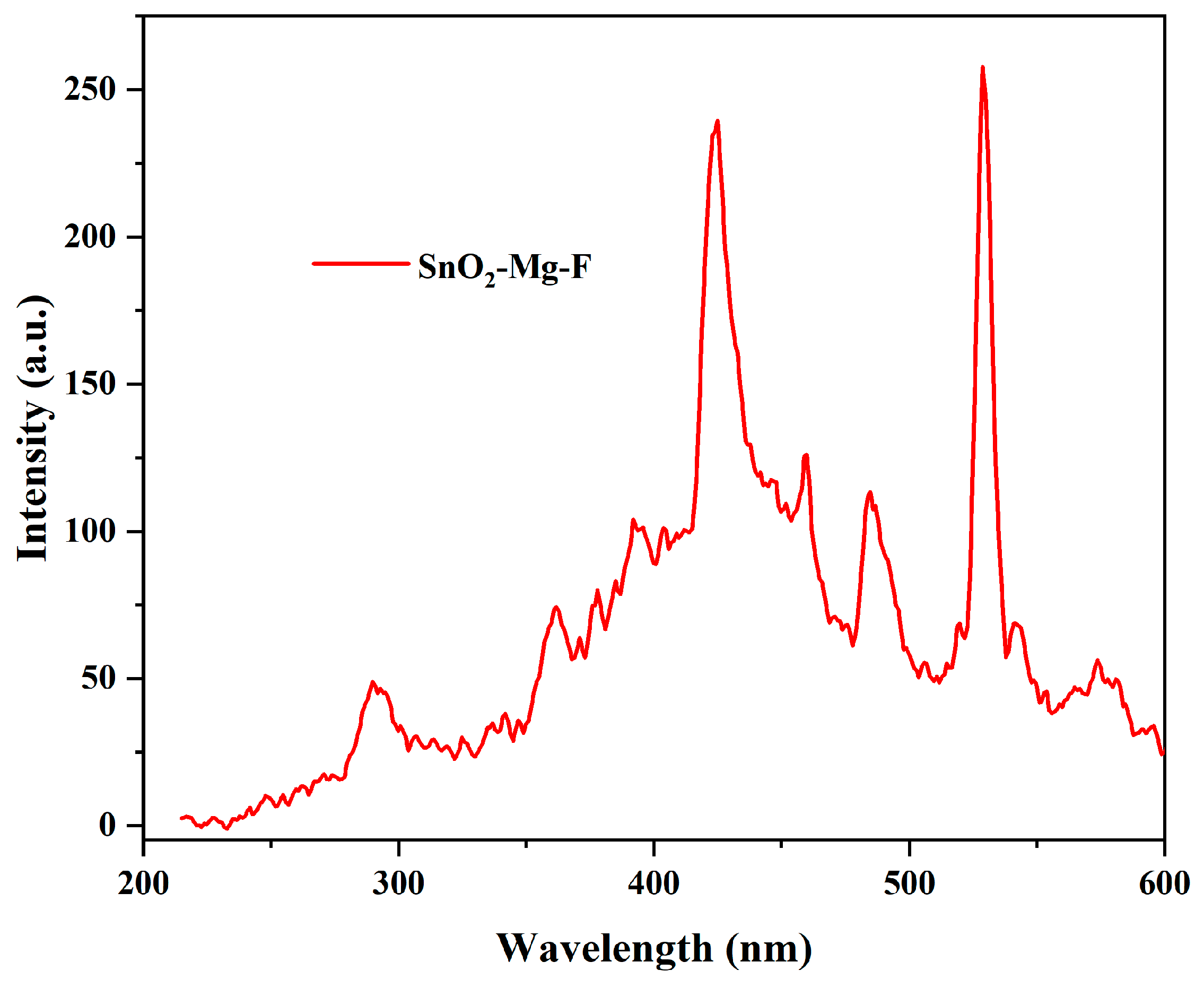
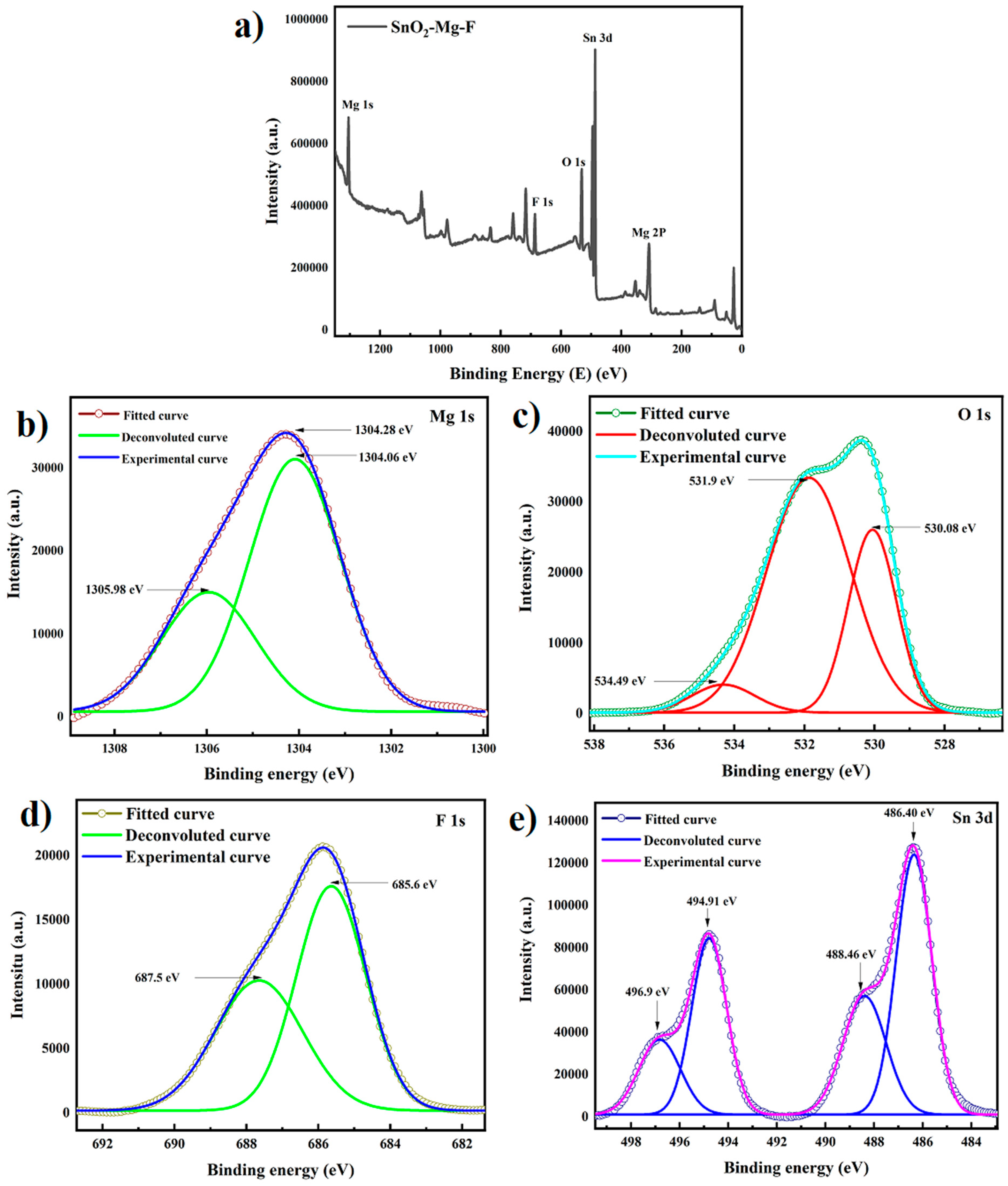
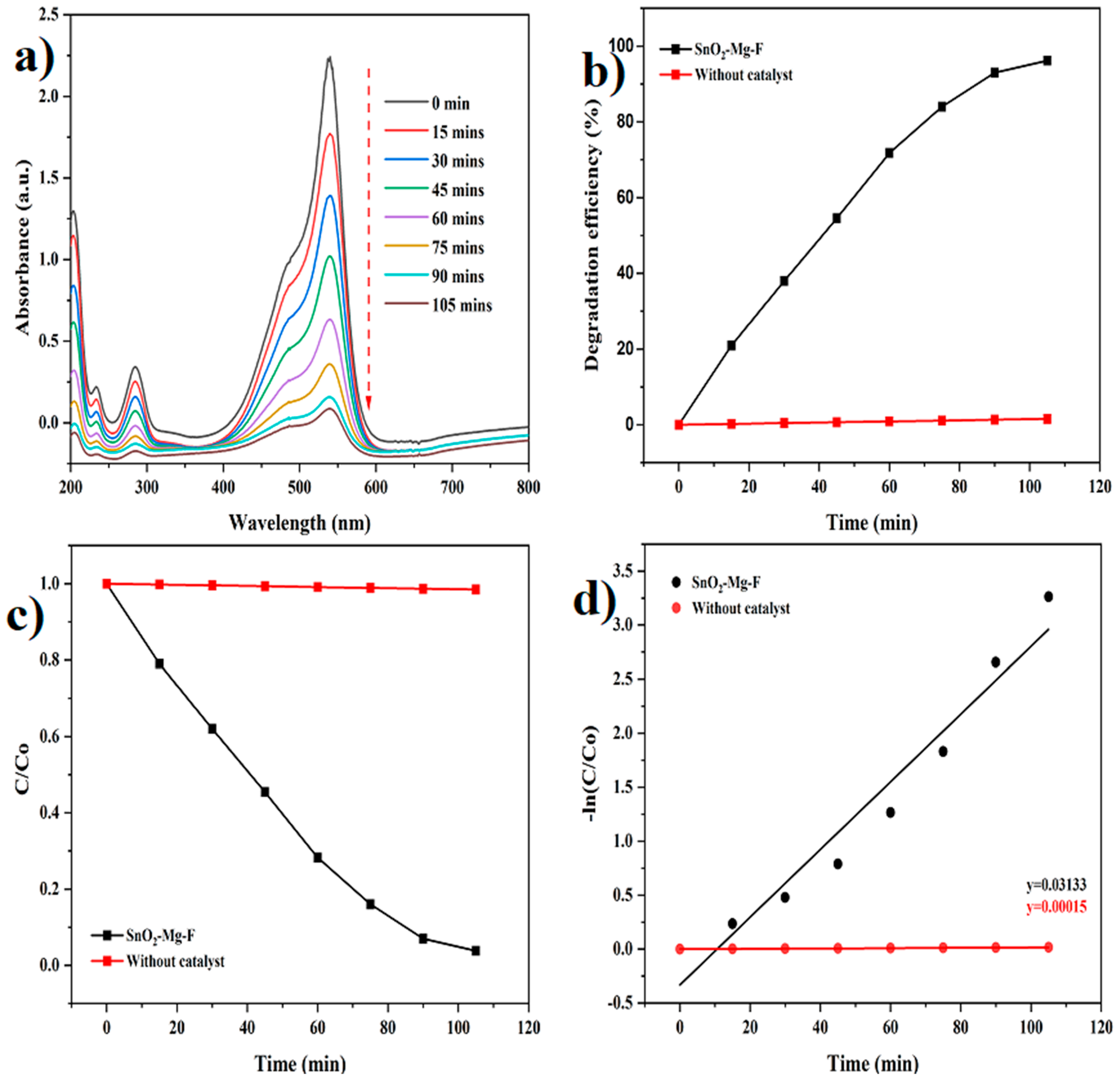

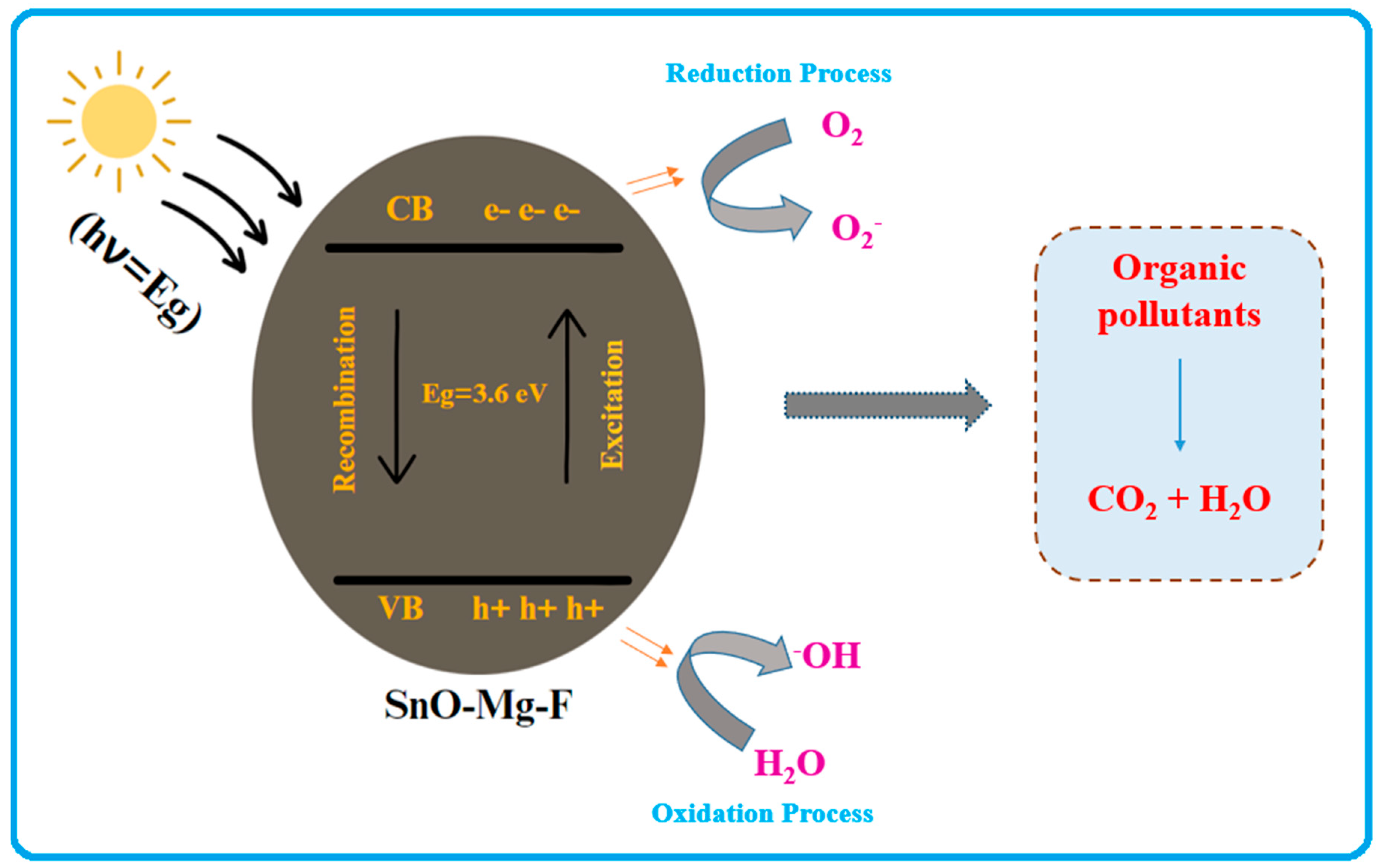
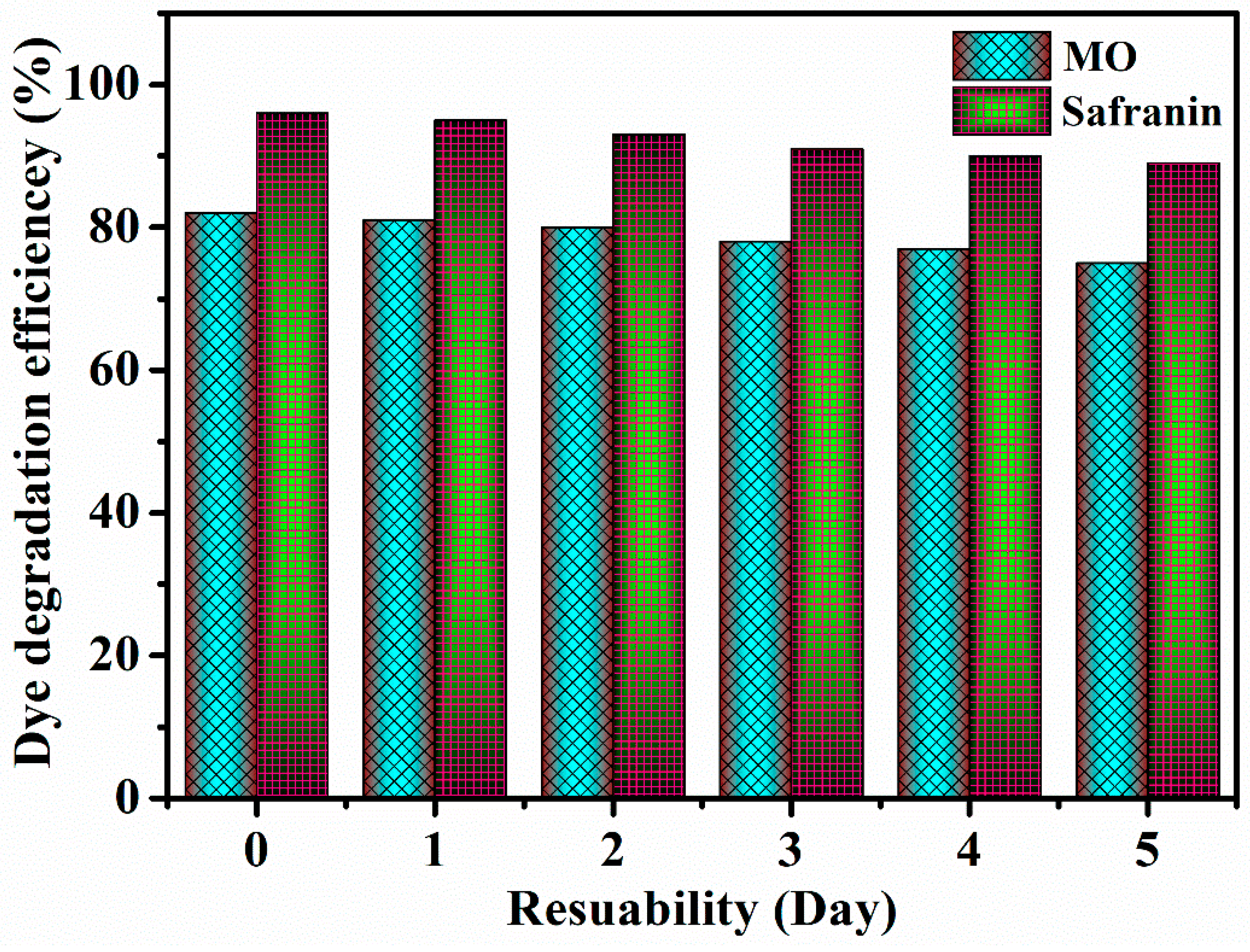
| Photocatalyst | Synthesis Method | Crystal Size (nm) | Bandgap (eV) | Dye | Reaction Time (min) | Degradation Efficiency (%) | Ref. |
|---|---|---|---|---|---|---|---|
| SnO2 | Green synthesis | 21 | 3.75 | Methylene blue | 120 | 89 | [68] |
| SnO2 | Green synthesis | 7.6 | 3.8 | Rhodamine B | 150 | 92 | [69] |
| SnO2 | sol–gel | 14.2 | 3.92 | Methylene blue | 90 | 93 | [70] |
| SnO2 | sol-gel | 14.2 | 3.92 | Methyl Orange | 90 | 84 | |
| ZnO–SnO2 | Hydrothermal | 30 | 3.4 | Methylene blue | 75 | 70 | [71] |
| Sr–SnO2 | Sol-gel | 8.3 | 3.7 | Methylene Orange | 120 | 94 | [72] |
| Mg–SnO2 | Vapour pressure method | 17.5 | 3.6 | Alizarin Red S | 120 | 75 | [73] |
| F–TiO2 | Sol-gel | 18.79 | 3.3 | Methylene blue | 120 | 91 | [74] |
| F–N–TiO2 | Hydrothermal | 20.6 | 3.5 | Methylene blue | 90 | 95 | [75] |
Disclaimer/Publisher’s Note: The statements, opinions and data contained in all publications are solely those of the individual author(s) and contributor(s) and not of MDPI and/or the editor(s). MDPI and/or the editor(s) disclaim responsibility for any injury to people or property resulting from any ideas, methods, instructions or products referred to in the content. |
© 2023 by the authors. Licensee MDPI, Basel, Switzerland. This article is an open access article distributed under the terms and conditions of the Creative Commons Attribution (CC BY) license (https://creativecommons.org/licenses/by/4.0/).
Share and Cite
Velmurugan, G.; Ganapathi Raman, R.; Sivaprakash, P.; Viji, A.; Cho, S.H.; Kim, I. Functionalization of Fluorine on the Surface of SnO2–Mg Nanocomposite as an Efficient Photocatalyst for Toxic Dye Degradation. Nanomaterials 2023, 13, 2494. https://doi.org/10.3390/nano13172494
Velmurugan G, Ganapathi Raman R, Sivaprakash P, Viji A, Cho SH, Kim I. Functionalization of Fluorine on the Surface of SnO2–Mg Nanocomposite as an Efficient Photocatalyst for Toxic Dye Degradation. Nanomaterials. 2023; 13(17):2494. https://doi.org/10.3390/nano13172494
Chicago/Turabian StyleVelmurugan, G., R. Ganapathi Raman, P. Sivaprakash, A. Viji, Shin Hum Cho, and Ikhyun Kim. 2023. "Functionalization of Fluorine on the Surface of SnO2–Mg Nanocomposite as an Efficient Photocatalyst for Toxic Dye Degradation" Nanomaterials 13, no. 17: 2494. https://doi.org/10.3390/nano13172494
APA StyleVelmurugan, G., Ganapathi Raman, R., Sivaprakash, P., Viji, A., Cho, S. H., & Kim, I. (2023). Functionalization of Fluorine on the Surface of SnO2–Mg Nanocomposite as an Efficient Photocatalyst for Toxic Dye Degradation. Nanomaterials, 13(17), 2494. https://doi.org/10.3390/nano13172494






